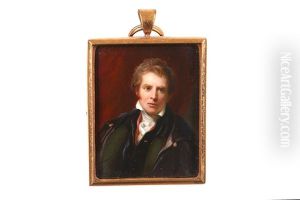William Essex Paintings
William Essex was a renowned British artist, celebrated for his exquisite enamel paintings, a medium that harkens back to the intricate works of the Renaissance period. Born in 1784, Essex hailed from a modest background in London, England. Despite the limited educational resources available to him, his innate talent and passion for art propelled him into the limelight of the British art scene. Essex's journey into the arts began with an apprenticeship under the tutelage of William Pether, a respected artist known for his mezzotint works. This foundational period was crucial in shaping Essex's artistic direction, providing him with a solid grounding in the principles of painting and craftsmanship.
Throughout his career, Essex specialized in enamel painting, a meticulous and labor-intensive process that involves fusing powdered glass to a substrate by firing it at high temperatures. This technique allowed for a vibrancy and durability of color that was unmatched by other mediums of the time. Essex's subjects ranged from portraits of eminent figures of his era to intricate reproductions of famous paintings by old masters. His ability to capture the essence and likeness of his subjects with remarkable accuracy and depth made his works highly sought after by the aristocracy and royalty, including Queen Victoria herself, who was an avid collector of his works.
Essex's contributions to the art world were not limited to his own creations. He played a significant role in the revival of enamel art in 19th-century Britain, a period when interest in traditional craft techniques was waning in favor of industrial production methods. Through his efforts, Essex helped to preserve a critical link to the artistic heritage of the past, inspiring future generations of artists to explore the potential of enamel painting.
His legacy is not merely in the beauty of his works but also in his influence on the artists who followed him. Essex's dedication to his craft and his success in elevating enamel painting to a respected art form in its own right marked him as a pivotal figure in the British art scene of the 19th century. William Essex passed away in 1869, leaving behind a body of work that continues to be admired for its technical mastery and aesthetic beauty. His life and work remain a testament to the enduring appeal of traditional art forms in an ever-changing world.






















